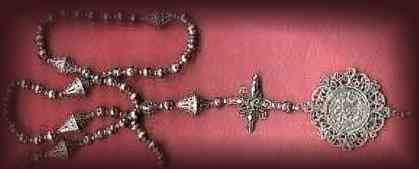|
During the 1600's, the Apostles Creed is added to the Rosary Prayer and the overall configuration and prayer sequence of the Rosary is becoming more and more universally the same throughout Europe. In 1627 King Louis the XIII of France orders public recitation of the Rosary against the rebellious Huguenots. Fifteen thousand Rosaries are distributed to the troops with set hours of prayer. The battle is won and France is saved. + FILIGREE BEADS BECOME POPULAR Old records and inventories recently found reveal that Rosaries were being made in the Orient for European use in the 1600s. Amber, crystal, coral and fine, aromatic woods are the most popular. Rosaries made in Portuguese India are highly prized from a ’very early date’as are filigree beads made of silver from the Middle East. for more information see IMAGE - DIRECTORY |
|
~ IMAGE ~ |
 |
|
~ DIRECTORY ~ |
|
silver capped wooden beads with traditional filigree medallion |
|
A remarkable and rare example of an antique Jubilee rosary |
|
filled with antique medallions possibly charting a pilgrimage |
![]()
|
St. Louis DeMontfort is born in Brittany in 1673. He will be the founder of two religious orders in his lifetime. Many of his sermons are now in book form, ‘True Devotion to Mary,’‘The Secret of Mary’ and the ‘Secret of the Rosary’ are the most popular. Today these books guide those who choose to Consecrate their lives to Jesus through Mary. + Ten years later, the Saracens try to invade Austria. Their navy is broken but their army is strong. They try to take over the Balkan area by going into Vienna. King Leopold turns to Our Lady of the Rosary and the city is miraculously saved. |
![]()
![]()
|
for more information ANTIQUE ROSARY MUSEUM INDEX TOP OF PAGE |
![]()
|
|
|
|
|
|
|
|
|
|
|
|
|
|